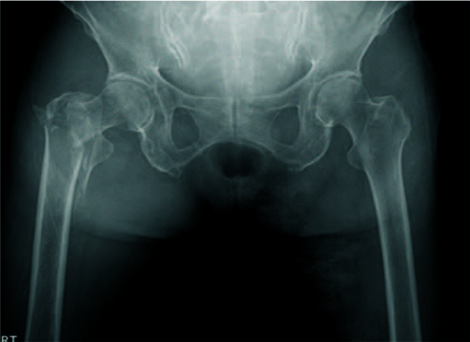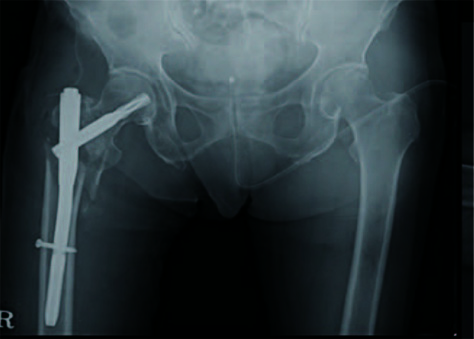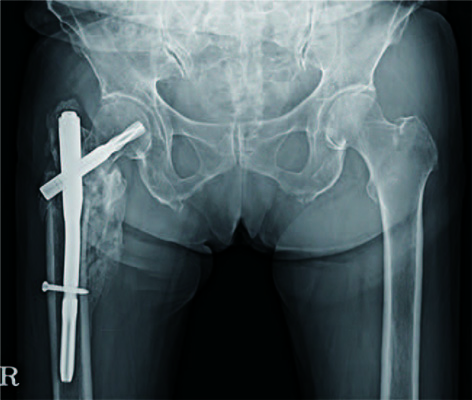Hip Pelvis.
2014 Mar;26(1):41-44. 10.5371/hp.2014.26.1.41.
Unusual Excessive Callus Formation in the Intertrochanteric Fracture Treated with Teriparatide
- Affiliations
-
- 1Department of Orthopedic Surgery, Korea University Anam Hospital, Korea University College of Medicine, Seoul, Korea. oshan@korea.ac.kr
- KMID: 2054161
- DOI: http://doi.org/10.5371/hp.2014.26.1.41
Abstract
- This is the first case report on the effects of teriparatide on the course of healing of an intertrochanteric hip fracture with unusually excessive callus formation even after discontinuation of treatment in an elderly woman. This case highlights the long-term effects of parathyroid hormone, even after administration of short-term, intermittent dosages for healing of osteoporotic fracture.
MeSH Terms
Figure
Reference
-
1. Dempster DW, Cosman F, Parisien M, Shen V, Lindsay R. Anabolic actions of parathyroid hormone on bone. Endocr Rev. 1993; 14:690–709.
Article2. Hodsman AB, Bauer DC, Dempster DW, et al. Parathyroid hormone and teriparatide for the treatment of osteoporosis: a review of the evidence and suggested guidelines for its use. Endocr Rev. 2005; 26:688–703.
Article3. Andreassen TT, Ejersted C, Oxlund H. Intermittent parathyroid hormone (1-34) treatment increases callus formation and mechanical strength of healing rat fractures. J Bone Miner Res. 1999; 14:960–968.
Article4. Skripitz R, Andreassen TT, Aspenberg P. Parathyroid hormone (1-34) increases the density of rat cancellous bone in a bone chamber. A dose-response study. J Bone Joint Surg Br. 2000; 82:138–141.5. Vahle JL, Sato M, Long GG, et al. Skeletal changes in rats given daily subcutaneous injections of recombinant human parathyroid hormone (1-34) for 2 years and relevance to human safety. Toxicol Pathol. 2002; 30:312–321.
Article6. Aspenberg P, Genant HK, Johansson T, et al. Teriparatide for acceleration of fracture repair in humans: a prospective, randomized, double-blind study of 102 postmenopausal women with distal radial fractures. J Bone Miner Res. 2010; 25:404–414.
Article7. Peichl P, Holzer LA, Maier R, Holzer G. Parathyroid hormone 1-84 accelerates fracture-healing in pubic bones of elderly osteoporotic women. J Bone Joint Surg Am. 2011; 93:1583–1587.
Article
- Full Text Links
- Actions
-
Cited
- CITED
-
- Close
- Share
- Similar articles
-
- Effects of Teriparatide Administration on Fracture Healing after Intramedullary Nailing in Atypical Femoral Fractures
- Effect of Postoperative Parathyroid Hormone Administration on Osteoporotic Intertrochanteric Fractures of Females
- Intermittent Parathyroid Hormone Treatment for Stimulation of Callus Formation on Distal Femoral Fracture in Elderly Patients: Case Report
- Brachial Plexus Injury Secondary to Exuberant Callus Formation of Fracture of Clavicle : Two Cases Report
- Delayed Brachial Plexus Palsy due to Clavicular Fracture: A Case Report






